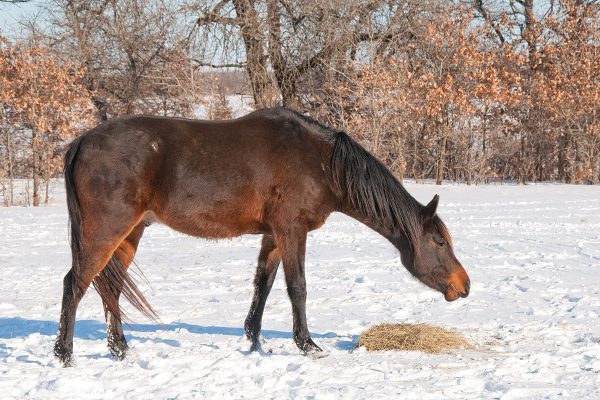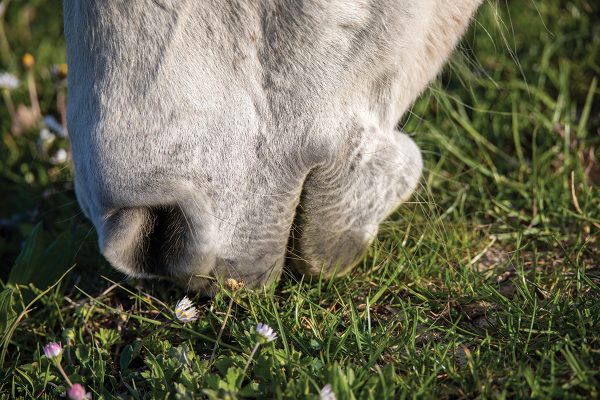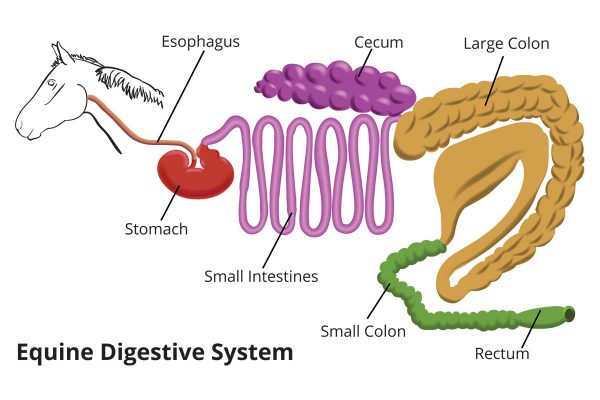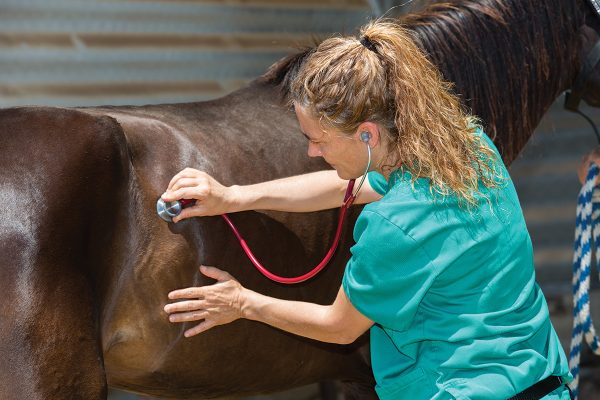
Unlike us, horses have very complicated digestive systems. Known as “hindgut fermenters,” horses’ intestines take weird twists and turns with some unexpected surprises, all to grass and hay. Let’s take a tour of the horse’s digestive tract from mouth to tail.
Biting and Chewing
If you were a blade of grass, your fate would be sealed starting at the horse’s mouth. The horse’s incisors, or front teeth, easily snip grass into bite-sized pieces. Then the tongue, made of strong muscle, moves the grass to the back of the mouth, where it is ground down by large molars with ridged surfaces.
Watch your horse chew and notice the side-to-side motion of his jaw. This movement is perfect for grinding tough fiber into smaller pieces. Sometimes horses develop sharp points on their molars that result in uneven chewing and mouth sores that are very painful. Regular dental filing, called floating, done by your veterinarian will help prevent this from happening.
To the Stomach
Next, the grass is swallowed and travels down the esophagus, a muscular tube connecting the throat to the stomach. Occasionally, dry feed will get stuck here. This is called choke, which is a little confusing, because it has nothing to do with the horse’s breathing ability.

If a horse has a case of choke, he can’t swallow, may drool, and will sometimes play in water but not drink. This is an emergency situation, so your veterinarian should be called right away to treat it.
Once down the esophagus, grass enters the stomach, a surprisingly small organ in the horse. Part of the stomach has special glands that secrete strong acid, which breaks down food. It is common for this acid to cause gastric ulcers in some horses due to stress, inappropriate feeding, and other issues. A veterinarian can diagnose gastric ulcers and then prescribe treatment and dietary changes for your horse if needed.
The stomach is also where bot fly larvae develop. Adult bot flies lay eggs on your horse’s legs. When he scratches, he accidentally swallows them, and they attach to the lining of the stomach and develop into larvae. Many common deworming medications prevent this type of infestation.
Small Intestine
Food doesn’t stay in the horse’s stomach for long. It moves quickly through the small intestine, an impressively long tube that can reach up to 70 feet in an adult horse! The small intestine is where digestion of protein and fat occurs, along with some carbohydrates.
Your horse needs the help of healthy bacteria and protozoa to do most of the digestion of grass and hay via chemical reactions called fermentation. This occurs beyond the small intestine in what is called the “hindgut.”
The small intestine is also a common location for many types of parasites, like roundworms and strongyles. Heavy parasite infestations can damage the lining of the small intestine, which hurts the horse’s ability to absorb nutrients and can result in weight loss and diarrhea.
Hindgut
So far, the horse’s digestive system has been similar to ours. But once out of the small intestine, we enter the maze of the hindgut. First stop: the cecum.

The cecum is a large, dead-end pouch-shaped organ on the lower right side of your horse’s belly near his flank. The cecum is where food is mixed with water and healthy microbes that always live inside your horse. These microbes are vital to the digestion of tough, fibrous food like grass and hay. A horse can’t digest this fibrous material on his own. Without these tiny creatures, he could not survive.
After several hours of fermentation (breakdown of food) in the cecum, food exits and is routed to the large colon, where fermentation continues—it’s a long process! Remember how the cecum is on the right side? After leaving the cecum, food enters the first part of the large colon, called the ventral colon. Ventral means “bottom,” so this part runs along the bottom of your horse’s belly.
Near the pelvis, food takes a sharp turn straight up to the top of the horse in what is now called the dorsal colon. Dorsal means “top.” This tight turn is a common place for impaction colic, because it’s easy for food to get stuck here.

Once up in the dorsal colon, food travels toward the horse’s head again and makes a right turn behind the rib cage, heading back toward the tail for a short section called the transverse colon.
After this, guess what? Yep, still more colon! But we are getting to the end; next is the small colon, the final place of last-minute fermentation and absorption of water and nutrients. The small colon has tight muscular bands that mold the digested food into the characteristic manure balls we all know.
Then, it’s on to the rectum and out the horse—digestion complete!
This article about a horse’s digestive system appeared in the Winter 2022 issue of Young Rider magazine. Click here to subscribe!


